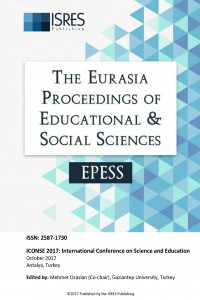Research Article
Year 2017,
Volume: 8 , 1 - 8, 08.12.2017
Abstract
In this study, human behaviour, and events started by
humans and effecting humans have been calculated with a determinist method.
Model has been established with the help of matrix and determinant subjects of
linear algebra. Events that are caused by humans and effect humans, and take a
certain time, and human behaviour have been calculated as numeric values. With
this mathematical model, human behaviour has become deterministically
calculable to a certain level.Calculation of the reduced level of human emotion
and behaviour may be perceived by robots. In this way the robots behave like
human by understanding of human emotion and behaviour.
References
- R. Cooksey, Judgment Analysis: Theory, Methods, and Applications,1996 California, San Diego. C.N. Kim, R. McLeod Jr., Expert, linear models, and nonlinear models of expert decision-making in bankruptcy prediction, Journal of Management Information Systems 16 (1) (1999). K. Levi, Expert systems should be more accurate than human experts, IEEE Transactions on Systems, Man, and Cybernetics 19 (3) (1989). O. Svenson, Process descriptions of decision-making, Organizational Behavior Human Performance 23 (1) (1979). C. N. Kim, K. H. Yang, J. Kim, Human decision-making behavior and modeling effects, Decision Support Systems 45 (2008). C. N. Kim, H. M. Chung, D. B. Paradice, Inductive modelling of expert decision making in loan evaluation: a decision strategy perspective, Decision Support Systems 21 (1997). C.J. Casey, Prior probability disclosure and loan officers' judgments: some evidence of the impact. J. Accounting Res. 21 ( 1 ) (1983) 300-307. LR. Goldberg, Man versus model of man: just how conflicting is that evidence?, Organizational Behavior Human Performance 16 (1) (1976) 13-22. J.W. Payne, Task complexity and contingent processing in decision making, Organizational Behavior Human Performance 16 (2) (1976) 366-387. 1. Zimmer.A lens study of the prediction of corporate failure by bank loan officers, J. Accounting Res. 18 (2) (1980) 629-636. C. H.Edward,D.E. Penney,GeorgiaUniversity; Differential Equations and edge value problems Computer supported mathematical modelling.
Year 2017,
Volume: 8 , 1 - 8, 08.12.2017
Abstract
References
- R. Cooksey, Judgment Analysis: Theory, Methods, and Applications,1996 California, San Diego. C.N. Kim, R. McLeod Jr., Expert, linear models, and nonlinear models of expert decision-making in bankruptcy prediction, Journal of Management Information Systems 16 (1) (1999). K. Levi, Expert systems should be more accurate than human experts, IEEE Transactions on Systems, Man, and Cybernetics 19 (3) (1989). O. Svenson, Process descriptions of decision-making, Organizational Behavior Human Performance 23 (1) (1979). C. N. Kim, K. H. Yang, J. Kim, Human decision-making behavior and modeling effects, Decision Support Systems 45 (2008). C. N. Kim, H. M. Chung, D. B. Paradice, Inductive modelling of expert decision making in loan evaluation: a decision strategy perspective, Decision Support Systems 21 (1997). C.J. Casey, Prior probability disclosure and loan officers' judgments: some evidence of the impact. J. Accounting Res. 21 ( 1 ) (1983) 300-307. LR. Goldberg, Man versus model of man: just how conflicting is that evidence?, Organizational Behavior Human Performance 16 (1) (1976) 13-22. J.W. Payne, Task complexity and contingent processing in decision making, Organizational Behavior Human Performance 16 (2) (1976) 366-387. 1. Zimmer.A lens study of the prediction of corporate failure by bank loan officers, J. Accounting Res. 18 (2) (1980) 629-636. C. H.Edward,D.E. Penney,GeorgiaUniversity; Differential Equations and edge value problems Computer supported mathematical modelling.
There are 1 citations in total.
Details
| Journal Section | Articles |
|---|---|
| Authors | |
| Publication Date | December 8, 2017 |
| Published in Issue | Year 2017 Volume: 8 |
This work is licensed under a Creative Commons Attribution-NonCommercial-ShareAlike 4.0 International License.



